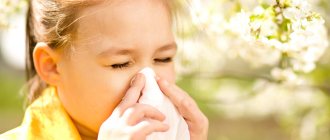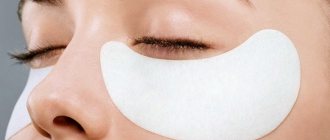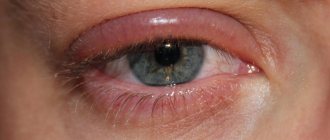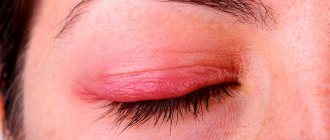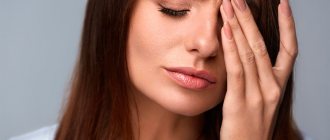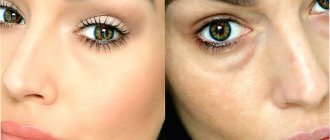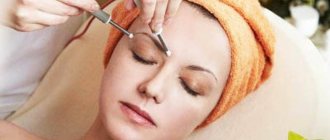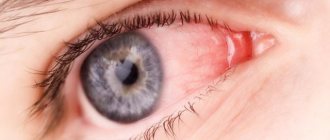Allergies around the eyes are considered an unpleasant disease and cause a lot of trouble, but in addition, they can cause serious problems. If not treated promptly, vision will deteriorate.
The skin around the eyes is considered the most delicate and thin. It suffers from exposure to various chemical irritants, so it ages earlier than in other areas. An allergic reaction occurs from improper care. The problem can be detected in autumn and winter when immunity decreases, as well as as a result of rapid perception of allergens.
Causes of allergies
Mostly, allergies around the eyes occur in people prone to them.
The main causes of allergies in the eyes:
- food allergies and improper eating schedule;
- disruptions in the digestive tract accompanied by intestinal dysbiosis;
- use of cosmetics with allergens;
- exposure to ultraviolet radiation from the sun on the body;
- infection with allergens through tap or well water.
To treat allergies under the eyes, complex treatment is prescribed
Causes
There are many reasons for a person to develop an allergic reaction, and their nature can vary greatly. The main ones are:
- Consequence of eye surgery or wearing contact lenses.
- Reaction to drugs.
- Dust that is in the house.
- Pollen. This type of allergy is typical for certain times of the year and is extremely difficult for people to tolerate.
- Cosmetics. It contains chemicals that can be harsh on the skin.
- Cold. Usually manifests itself in winter in the form of tears and redness of the cornea.
Depending on the reasons, the course of treatment may vary.
Types of allergies
Allergic conjunctivitis occurs in acute and chronic forms. There are bags under the eyes, watery eyes, red eyes and mucus formation. It occurs with the formation of edema and chemosis of the conjunctiva.
Allergic dermatitis is a disease of the eyelids. It appears when using cosmetics and medicines. With allergic dermatitis, the skin around the eyes becomes swollen and red. Papular rashes appear, which are accompanied by itching and burning.
Spring conjunctivitis is seasonal. The main reason is individual intolerance to high concentrations of ultraviolet radiation from solar radiation.
This type of allergy is not common. Some doctors believe that allergens are species of local flora. It affects boys from 7 to 15 years old.
Allergies on the eyelids cause a lot of inconvenience and trouble.
The child has a chronic phobia of light, itching and lacrimation. Sometimes it is possible to identify such pathologies as: proliferation of papillae on the eyelids and along the edge of the cornea, bags under the eyes.
Irritation to cold occurs in both children and adults. When exposed to cold air for a long time, swelling and redness of the eyelids, peeling and itching of the skin around the eyes appear. In children, it can be confused with chickenpox and measles. This is an immune response to cold.
Hay conjunctivitis mainly occurs in people allergic to pollen in the summer or spring.
This is typical: runny nose, sneezing, bags under the eyes, asthma attacks (including bronchial asthma) and skin reactions.
Allergy symptoms occur in those who wear contact lenses. They do not tolerate some components of lens solution or those included in contact lenses.
There are cases when the chemical components included in hairspray and deodorant settle on the lenses and provoke allergies.
Allergy under the eyes treatment
Today, allergic eye diseases are a pressing problem in ophthalmology. The number of cases increases significantly every year. According to the international classification of diseases, these conditions are included in the groups: unspecified inflammation of the eyelids, non-infectious inflammation of the eyelids, other specified inflammations of the eyelids. To prevent the occurrence of these conditions, it is necessary to avoid contact with allergens.
All diseases of the eyelids of a given nature can be systematized thanks to the classification:
Immediate allergic reactions
- Hives;
- Angioedema of the eyelids;
- Contact dermatitis of the eyelids.
Delayed allergic reactions
- Eczema of the eyelid skin;
- Toxicoderma.
The etiological factors that trigger the process are allergen antigens.
Clinical manifestations are characterized by individual characteristics in each individual case.
With urticaria, allergies under the eyes are expressed in the form of exudative, streakless elements. They look like a bright pink rash that rises slightly above the skin level. Sometimes elements disappear on their own without a trace. The onset of the disease is always acute, characterized by a feeling of severe itching and burning.
Quincke's edema is a form of urticaria. Often appears in the morning in the form of bags. The severity of edema can vary: from slight swelling to severe edema with closure of the palpebral fissure. Edema can affect not only the eyelids, but also all structures of the eye, as well as the entire face.
Allergic dermatitis most often occurs as a local reaction to medications (pastes, ointments, drops) or cosmetics (mascara, eye shadow). Each time, clinical manifestations appear 6 hours after repeated contact with the allergen. It is characterized by pronounced hyperemia, swelling and itching.
Eyelid eczema appears as dry, flaky skin under the eyes. Bubbles form, which burst, and a serous fluid appears, it dries and forms yellow straw crusts. Toxicoderma is characterized by single and petechial rashes, rarely in the form of exudative erythema. The manifestations pass and always reappear when a new portion of the allergen enters the body.
Allergies under the eyes require immediate treatment, like any allergic process. In severe cases, hormonal drugs are used locally and systemically. Antihistamine drops and disinfectant solutions are used locally. It is imperative to remove the allergen from all close contact areas. The state of the immune system is corrected. A hypoallergenic diet is recommended. In case of bacterial infection, antibiotics are used. Hydrocortisone or dexamethasone ointments are often used locally. Allergies under the eyes are often part of common allergy symptoms. At the first clinical manifestations, you should urgently consult a doctor. You cannot try to cope with the situation on your own.
Allergy symptoms
Allergic eye diseases, in addition to redness, are accompanied by various symptoms:
- itching;
- edema;
- secretion of tears;
- dry skin and flaking;
- purulent discharge from the eyes.
To identify the reason why your eyes swell, you need to undergo an examination by an ophthalmologist. Only after passing medical tests will he be able to determine the cause of the allergy and how to treat it.
For conjunctivitis, special attention is paid to the selection of eye drops
Allergy to the skin around the eyes - symptoms
Redness of the eyes due to allergies is accompanied by some other symptoms that will help make an accurate diagnosis and prescribe the correct treatment. The most striking and common symptoms
are considered:
- Swelling and redness of the eyelids, severe itching
- Peeling of the eyelid skin and a feeling of dry skin
- Increased tear production
- In rare cases, discharge from the eyes is observed. If they are purulent, there is every reason to assume that a secondary infection has joined the allergy.
To determine the exact cause of an allergic reaction and discomfort in the eyes, the patient is prescribed a series of examinations. It is necessary to take skin tests for various types of allergens, scrape the conjunctiva, check the percentage of vision and examine the cornea, eyelid margins and eyelashes for infection. Tear fluid is also analyzed for the presence of eosinophils.
Treatment methods
Allergies to the skin around the eyes are treated comprehensively. First, you need to completely eliminate contact with the identified allergen.
If you are allergic to cosmetics or medications, it is enough to stop using them and treat with antihistamines. Subsequently, completely eliminate these medications and cosmetics that caused such a reaction.
Hormonal medications are used to treat eye allergies. But this is only rational for chronic and severe allergies, when standard remedies have not had the desired effect. If a secondary infection occurs, antibiotics are prescribed.
Medicines that help relieve signs of eye disease:
Allergy ointments for the eyes (celestoderm, advantam).
They contain hormonal drugs. Therefore, they quickly have a positive effect. They are used according to prescription to avoid side complications. Apply the ointment to the skin of the eyelids in a thin layer.
If you use the ointment systematically, addiction may occur, your eyes will begin to itch and acne will appear.
Antihistamine tablets:
- cetrin - one tablet per day;
- tavegil;
- cetirizine - drink 1 tablet once a day;
- chloropyramine;
- suprastin;
- Zyrtec tablets;
- Levocetrizine.
Causes
To begin the fight against the disease, it is necessary to identify the cause of its occurrence. To do this, you should consult an allergist and undergo all tests (skin tests, scrapings, analysis of tear fluid). It would be a good idea to consult an ophthalmologist.
After identifying an allergen product, avoid all contact with it. The most likely cause of symptoms in women is low-quality and unnatural decorative cosmetics. In the spring-summer season, pollen and sun rays are often allergens.
Manifestations of allergies often occur after eating various foods. Also, our smaller brothers bring us a lot of trouble with our health - allergies to wool.
It is worth noting that a person with allergies should not keep pets in the house, including aquarium fish. Dry fish food is an allergen and shows its symptoms before the eyes.
A variety of chemical components that are included in powders and other cleaning products can be harmful. Manifestations of allergies in the eyes after taking medications are less common. Heredity plays an important role. People who often suffer from respiratory diseases are also at risk.
Rhinitis and throat diseases in most cases are accompanied by allergic reactions in the eyes. Redness and inflammation of the eyes are not uncommon in people who have undergone surgery.
Eye drops
Allergies to the skin around the eyes are accompanied by conjunctivitis.
It is recommended to use not only antihistamines, but also eye drops:
- Lecrolin.
- Opatanol.
- Allergodil.
- Cromohexal.
Herbal lotions are often used to treat eyes
Types of diseases
Eye diseases are different; they first affect the skin of the eyelids, and then can reach the retina and optic nerve. One of them is allergic dermatitis of the eyelids, which is more common than other ailments. It appears from the use of cosmetics. At this time, the following symptoms are observed:
- severe redness of the skin around the eyes;
- bubbles appear;
- the affected area swells;
- burning and itching occur.
Allergy season is when grasses, trees and flowers begin to bloom. During this period, pollen gets on the membranes of the eyes and causes hay fever conjunctivitis.
The disease is accompanied by the following symptoms:
- sneezing;
- skin rash;
- attacks of difficulty breathing;
- runny nose.
In the spring, allergy sufferers often develop keratoconjunctivitis. During the warm season, people cannot tolerate solar radiation, so they develop the disease. The disease is more common in boys than in girls. The allergy becomes chronic. Sick patients experience lacrimation, photophobia, and itching. Papillary growths appear on the conjunctiva of the eyelids.
Under no circumstances should you conduct independent experiments; attempts at self-medication lead to disastrous situations and serious consequences. Eyes are one of the important organs and treatment should only be carried out by a specialist.
Prevention
To protect yourself from such a dangerous problem, use the following preventive measures:
- Avoid cosmetics that contain a lot of different chemicals and choose only those that are medicinal. As a rule, such products do not cause irritation or allergies.
- If the allergy is caused by pollen, then try to go outside less during the period when it appears. In case of strong wind, do not ventilate the premises.
- Use hypoallergenic products.
- Observe all rules of personal hygiene. This is especially true for those people who wear contact lenses.
- Always provide timely treatment in the presence of acute or chronic diseases.
If you suffer from hay fever, it is better not to go outside in dry weather, because there will be a lot of pollen concentrated in the air. During periods of severe exacerbations, it is recommended to stay at home, at work, in places where contact with the allergen is minimal, from 11 am to 6 pm.
It is also recommended to have as little contact as possible with animals, especially street animals. They are often carriers of allergens.
Do not neglect prevention, it is the basis of healthy eyes.
